Samuel Teuber
Of Good Demons and Bad Angels: Guaranteeing Safe Control under Finite Precision
Jul 30, 2025Abstract:As neural networks (NNs) become increasingly prevalent in safety-critical neural network-controlled cyber-physical systems (NNCSs), formally guaranteeing their safety becomes crucial. For these systems, safety must be ensured throughout their entire operation, necessitating infinite-time horizon verification. To verify the infinite-time horizon safety of NNCSs, recent approaches leverage Differential Dynamic Logic (dL). However, these dL-based guarantees rely on idealized, real-valued NN semantics and fail to account for roundoff errors introduced by finite-precision implementations. This paper bridges the gap between theoretical guarantees and real-world implementations by incorporating robustness under finite-precision perturbations -- in sensing, actuation, and computation -- into the safety verification. We model the problem as a hybrid game between a good Demon, responsible for control actions, and a bad Angel, introducing perturbations. This formulation enables formal proofs of robustness w.r.t. a given (bounded) perturbation. Leveraging this bound, we employ state-of-the-art mixed-precision fixed-point tuners to synthesize sound and efficient implementations, thus providing a complete end-to-end solution. We evaluate our approach on case studies from the automotive and aeronautics domains, producing efficient NN implementations with rigorous infinite-time horizon safety guarantees.
Verification of Autonomous Neural Car Control with KeYmaera X
Apr 04, 2025Abstract:This article presents a formal model and formal safety proofs for the ABZ'25 case study in differential dynamic logic (dL). The case study considers an autonomous car driving on a highway avoiding collisions with neighbouring cars. Using KeYmaera X's dL implementation, we prove absence of collision on an infinite time horizon which ensures that safety is preserved independently of trip length. The safety guarantees hold for time-varying reaction time and brake force. Our dL model considers the single lane scenario with cars ahead or behind. We demonstrate that dL with its tools is a rigorous foundation for runtime monitoring, shielding, and neural network verification. Doing so sheds light on inconsistencies between the provided specification and simulation environment highway-env of the ABZ'25 study. We attempt to fix these inconsistencies and uncover numerous counterexamples which also indicate issues in the provided reinforcement learning environment.
Next Steps in LLM-Supported Java Verification
Feb 03, 2025Abstract:Recent work has shown that Large Language Models (LLMs) are not only a suitable tool for code generation but also capable of generating annotation-based code specifications. Scaling these methodologies may allow us to deduce provable correctness guarantees for large-scale software systems. In comparison to other LLM tasks, the application field of deductive verification has the notable advantage of providing a rigorous toolset to check LLM-generated solutions. This short paper provides early results on how this rigorous toolset can be used to reliably elicit correct specification annotations from an unreliable LLM oracle.
Revisiting Differential Verification: Equivalence Verification with Confidence
Oct 26, 2024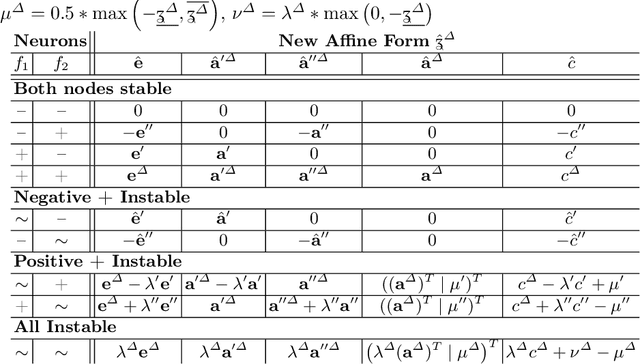
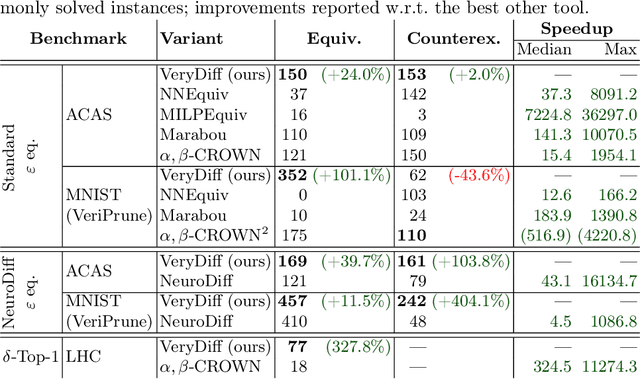
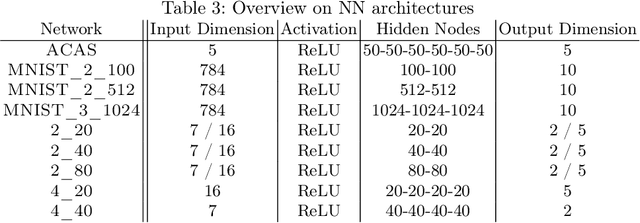
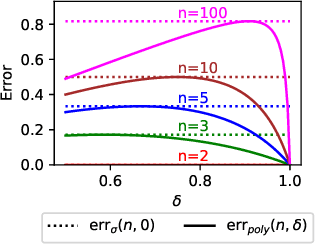
Abstract:When validated neural networks (NNs) are pruned (and retrained) before deployment, it is desirable to prove that the new NN behaves equivalently to the (original) reference NN. To this end, our paper revisits the idea of differential verification which performs reasoning on differences between NNs: On the one hand, our paper proposes a novel abstract domain for differential verification admitting more efficient reasoning about equivalence. On the other hand, we investigate empirically and theoretically which equivalence properties are (not) efficiently solved using differential reasoning. Based on the gained insights, and following a recent line of work on confidence-based verification, we propose a novel equivalence property that is amenable to Differential Verification while providing guarantees for large parts of the input space instead of small-scale guarantees constructed w.r.t. predetermined input points. We implement our approach in a new tool called VeryDiff and perform an extensive evaluation on numerous old and new benchmark families, including new pruned NNs for particle jet classification in the context of CERN's LHC where we observe median speedups >300x over the State-of-the-Art verifier alpha,beta-CROWN.
Provably Safe Neural Network Controllers via Differential Dynamic Logic
Feb 16, 2024Abstract:While neural networks (NNs) have a large potential as goal-oriented controllers for Cyber-Physical Systems, verifying the safety of neural network based control systems (NNCSs) poses significant challenges for the practical use of NNs -- especially when safety is needed for unbounded time horizons. One reason for this is the intractability of NN and hybrid system analysis. We introduce VerSAILLE (Verifiably Safe AI via Logically Linked Envelopes): The first approach for the combination of differential dynamic logic (dL) and NN verification. By joining forces, we can exploit the efficiency of NN verification tools while retaining the rigor of dL. We reflect a safety proof for a controller envelope in an NN to prove the safety of concrete NNCS on an infinite-time horizon. The NN verification properties resulting from VerSAILLE typically require nonlinear arithmetic while efficient NN verification tools merely support linear arithmetic. To overcome this divide, we present Mosaic: The first sound and complete verification approach for polynomial real arithmetic properties on piece-wise linear NNs. Mosaic lifts off-the-shelf tools for linear properties to the nonlinear setting. An evaluation on case studies, including adaptive cruise control and airborne collision avoidance, demonstrates the versatility of VerSAILLE and Mosaic: It supports the certification of infinite-time horizon safety and the exhaustive enumeration of counterexample regions while significantly outperforming State-of-the-Art tools in closed-loop NNV.
An Information-Flow Perspective on Algorithmic Fairness
Dec 15, 2023Abstract:This work presents insights gained by investigating the relationship between algorithmic fairness and the concept of secure information flow. The problem of enforcing secure information flow is well-studied in the context of information security: If secret information may "flow" through an algorithm or program in such a way that it can influence the program's output, then that is considered insecure information flow as attackers could potentially observe (parts of) the secret. There is a strong correspondence between secure information flow and algorithmic fairness: if protected attributes such as race, gender, or age are treated as secret program inputs, then secure information flow means that these ``secret'' attributes cannot influence the result of a program. While most research in algorithmic fairness evaluation concentrates on studying the impact of algorithms (often treating the algorithm as a black-box), the concepts derived from information flow can be used both for the analysis of disparate treatment as well as disparate impact w.r.t. a structural causal model. In this paper, we examine the relationship between quantitative as well as qualitative information-flow properties and fairness. Moreover, based on this duality, we derive a new quantitative notion of fairness called fairness spread, which can be easily analyzed using quantitative information flow and which strongly relates to counterfactual fairness. We demonstrate that off-the-shelf tools for information-flow properties can be used in order to formally analyze a program's algorithmic fairness properties, including the new notion of fairness spread as well as established notions such as demographic parity.
Geometric Path Enumeration for Equivalence Verification of Neural Networks
Dec 13, 2021

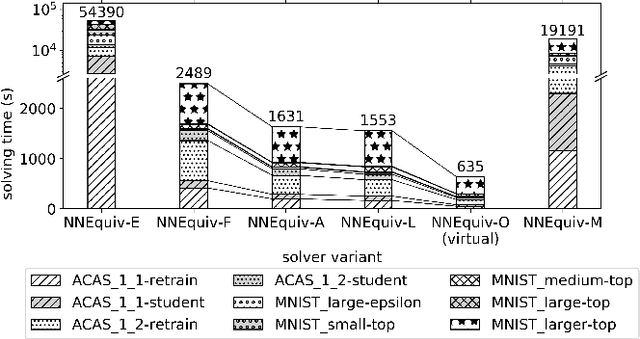
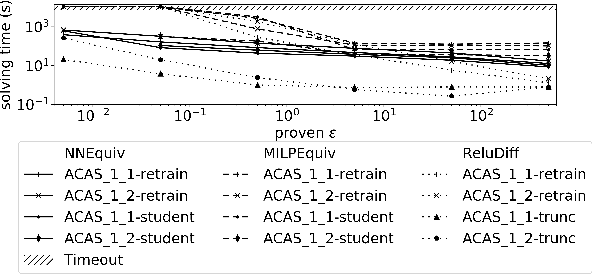
Abstract:As neural networks (NNs) are increasingly introduced into safety-critical domains, there is a growing need to formally verify NNs before deployment. In this work we focus on the formal verification problem of NN equivalence which aims to prove that two NNs (e.g. an original and a compressed version) show equivalent behavior. Two approaches have been proposed for this problem: Mixed integer linear programming and interval propagation. While the first approach lacks scalability, the latter is only suitable for structurally similar NNs with small weight changes. The contribution of our paper has four parts. First, we show a theoretical result by proving that the epsilon-equivalence problem is coNP-complete. Secondly, we extend Tran et al.'s single NN geometric path enumeration algorithm to a setting with multiple NNs. In a third step, we implement the extended algorithm for equivalence verification and evaluate optimizations necessary for its practical use. Finally, we perform a comparative evaluation showing use-cases where our approach outperforms the previous state of the art, both, for equivalence verification as well as for counter-example finding.
* Paper presented at The 33rd IEEE International Conference on Tools with Artificial Intelligence (ICTAI)
 Add to Chrome
Add to Chrome Add to Firefox
Add to Firefox Add to Edge
Add to Edge